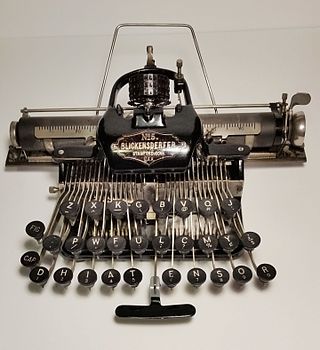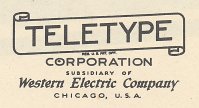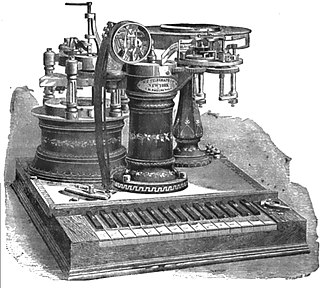
ASCII, abbreviated from American Standard Code for Information Interchange, is a character encoding standard for electronic communication. ASCII codes represent text in computers, telecommunications equipment, and other devices. Because of technical limitations of computer systems at the time it was invented, ASCII has just 128 code points, of which only 95 are printable characters, which severely limited its scope. Modern computer systems have evolved to use Unicode, which has millions of code points, but the first 128 of these are the same as the ASCII set.

The Baudot code is an early character encoding for telegraphy invented by Émile Baudot in the 1870s. It was the predecessor to the International Telegraph Alphabet No. 2 (ITA2), the most common teleprinter code in use before ASCII. Each character in the alphabet is represented by a series of five bits, sent over a communication channel such as a telegraph wire or a radio signal by asynchronous serial communication. The symbol rate measurement is known as baud, and is derived from the same name.

In the field of computing, a printer is considered a peripheral device that serves the purpose of creating a permanent representation of text or graphics, usually on paper. While the majority of outputs produced by printers are readable by humans, there are instances where barcode printers have found a utility beyond this traditional use. Different types of printers are available for use, including inkjet printers, thermal printers, laser printers, and 3D printers.
In computing and telecommunication, a control character or non-printing character (NPC) is a code point in a character set that does not represent a written character or symbol. They are used as in-band signaling to cause effects other than the addition of a symbol to the text. All other characters are mainly graphic characters, also known as printing characters, except perhaps for "space" characters. In the ASCII standard there are 33 control characters, such as code 7, BEL, which rings a terminal bell.

Digital data, in information theory and information systems, is information represented as a string of discrete symbols, each of which can take on one of only a finite number of values from some alphabet, such as letters or digits. An example is a text document, which consists of a string of alphanumeric characters. The most common form of digital data in modern information systems is binary data, which is represented by a string of binary digits (bits) each of which can have one of two values, either 0 or 1.

Electrical telegraphs were point-to-point text messaging systems, primarily used from the 1840s until the late 20th century. It was the first electrical telecommunications system and the most widely used of a number of early messaging systems called telegraphs, that were devised to communicate text messages more quickly than physical transportation. Electrical telegraphy can be considered to be the first example of electrical engineering.

Jean-Maurice-Émile Baudot, French telegraph engineer and inventor of the first means of digital communication Baudot code, was one of the pioneers of telecommunications. He invented a multiplexed printing telegraph system that used his code and allowed multiple transmissions over a single line. The baud unit was named after him.

Morse code is a method used in telecommunication to encode text characters as standardized sequences of two different signal durations, called dots and dashes, or dits and dahs. Morse code is named after Samuel Morse, one of the early developers of the system adopted for electrical telegraphy.

A teleprinter is an electromechanical device that can be used to send and receive typed messages through various communications channels, in both point-to-point and point-to-multipoint configurations.

Ticker tape was the earliest electrical dedicated financial communications medium, transmitting stock price information over telegraph lines, in use from around 1870 through 1970. It consisted of a paper strip that ran through a machine called a stock ticker, which printed abbreviated company names as alphabetic symbols followed by numeric stock transaction price and volume information. The term "ticker" came from the sound made by the machine as it printed.
A telegraph code is one of the character encodings used to transmit information by telegraphy. Morse code is the best-known such code. Telegraphy usually refers to the electrical telegraph, but telegraph systems using the optical telegraph were in use before that. A code consists of a number of code points, each corresponding to a letter of the alphabet, a numeral, or some other character. In codes intended for machines rather than humans, code points for control characters, such as carriage return, are required to control the operation of the mechanism. Each code point is made up of a number of elements arranged in a unique way for that character. There are usually two types of element, but more element types were employed in some codes not intended for machines. For instance, American Morse code had about five elements, rather than the two of International Morse Code.

The Blickensderfer typewriter was invented by George Canfield Blickensderfer (1850–1917) and patented on April 12, 1892. Blickensderfer was a nephew of John Celivergos Zachos, the inventor of the stenotype. Two models, Model 1 and Model 5, were unveiled to the public at the 1893 World's Columbian Exposition in Chicago. The Model 5 was a stripped-down version of the bigger, more complex Model 1. These machines were intended to compete with larger Remington, Hammond and Yost typewriters, and were the first truly portable, full-keyboard typewriters. The design also enabled the typist to see the typed work, at a time when most typewriters were understrike machines that concealed the writing. When Blickensderfer unveiled his small Model 5, its compactness and novel features attracted huge crowds and many orders.
Royal Earl House was the inventor of the first printing telegraph, which is kept in the Smithsonian Institution. His nephew Henry Alonzo House was also an early American inventor.

The Teletype Corporation, a part of American Telephone and Telegraph Company's Western Electric manufacturing arm since 1930, came into being in 1928 when the Morkrum-Kleinschmidt Company changed its name to the name of its trademark equipment. Teletype was responsible for the research, development and manufacture of data and record communications equipment, but it is primarily remembered for the manufacture of electromechanical teleprinters.
Telex or TELEX, is a convention for encoding Vietnamese text in plain ASCII characters. Originally used for transmitting Vietnamese text over telex systems, it is one of the most used input method on phones and touchscreens and also computers. Vietnamese Morse code uses the TELEX system. Other systems include VNI and VIQR.
Edward Ernst Kleinschmidt was a German-American engineer. He was one of the inventors of the teleprinter, and obtained 118 patents over the course of his lifetime.

A computer keyboard is a peripheral input device modeled after the typewriter keyboard which uses an arrangement of buttons or keys to act as mechanical levers or electronic switches. Replacing early punched cards and paper tape technology, interaction via teleprinter-style keyboards have been the main input method for computers since the 1970s, supplemented by the computer mouse since the 1980s.

The Sholes and Glidden typewriter was the first commercially successful typewriter. Principally designed by the American inventor Christopher Latham Sholes, it was developed with the assistance of fellow printer Samuel W. Soule and amateur mechanic Carlos S. Glidden. Work began in 1867, but Soule left the enterprise shortly thereafter, replaced by James Densmore, who provided financial backing and the driving force behind the machine's continued development. After several short-lived attempts to manufacture the device, the machine was acquired by E. Remington and Sons in early 1873. An arms manufacturer seeking to diversify, Remington further refined the typewriter before finally placing it on the market on July 1, 1874.

George May Phelps was a 19th-century American inventor of automated telegraphy equipment. He is credited with synthesizing the designs of several existing printers into his line of devices which became the dominant apparatus for automated reception and transmission of telegraph messages.

Donald Murray was an electrical engineer and the inventor of a telegraphic typewriter system using an extended Baudot code that was a direct ancestor of the teleprinter. He can justifiably be called the "Father of the remote Typewriter".
















